- The Growing Threat of AI-powered Cyberattacks in 2025
- I test tablets for a living and this is the Samsung tablet I recommend the most
- The Cost of Ignoring Patches: How State and Local Governments Can Mitigate Damaging Security Breaches
- I turned this 98-inch TV into an immersive at-home theater system (and it's $1,500 off)
- You can save $30 on the Apple Pencil Pro right now
Wi-Fi 7’s Multi-Link Operation (MLO) Dissection—from Packets to Performance
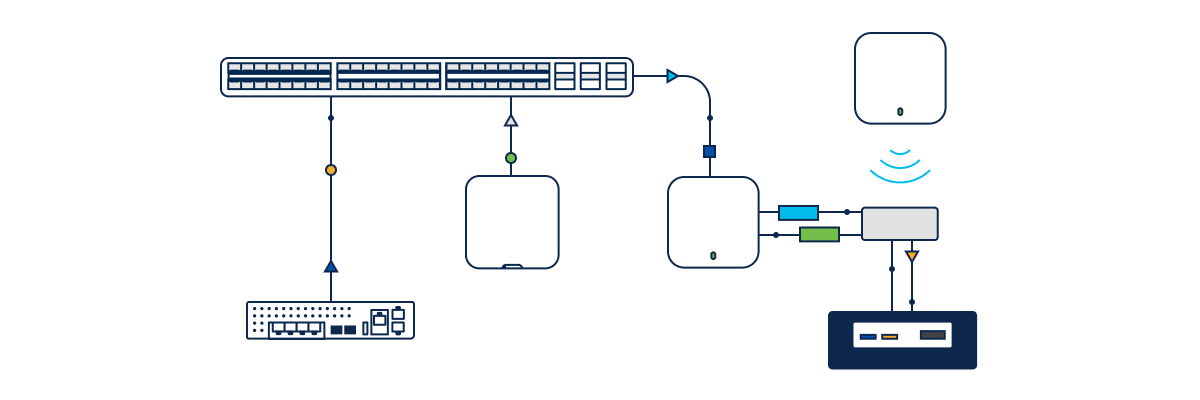
There’s a great deal of talk around the capability of Wi-Fi 7 (IEEE 802.11be) to revolutionize the wireless experience. It’s not hype. A key feature that delivers this transformative impact is multi-link operation (MLO). A mandatory and defining component of 802.11be, MLO enables a multi-link device (MLD) to simultaneously operate across multiple frequency bands, including 2.4 GHz, 5 GHz, and 6 GHz.
Access point (AP) and non-AP MLDs learn each other’s MLO parameters and capabilities through the multi-link information elements exchanged in frames like Beacons and Association Request/Response. In this blog, I’ll illustrate MLO’s impact on wireless connectivity and show you how it works in simultaneous transfer/receive (STR) mode.
How does multi-link operation (MLO) enhance wireless connectivity?
MLO introduces significant benefits for a variety of use cases. Key enhancements include:
- Simultaneous use of multiple bands. MLDs can transmit (Tx) and receive (Rx) data over more than one band at the same time. This is useful in environments with heavy congestion, as it avoids interference on any single band.
- Improved throughput. MLO leverages the combined capacity of multiple channels across different bands to enable higher aggregate throughput. This makes Wi-Fi 7 ideal for bandwidth-heavy applications like video streaming, virtual reality, and online gaming.
- Reduced latency. By offloading traffic across multiple channels. This is particularly useful in gaming, video conferencing, or other apps that require real-time communication.
- Better reliability and robustness. If one band (for example, 2.4 GHz) experiences congestion, then station (STA) MLDs can seamlessly switch to a less congested band (such as 6 GHz) without dropping the connection. This is extremely helpful in spaces with busy radio frequency (RF) traffic, such as stadiums, apartments, and offices.
Type of MLO operation modes
Wi-Fi 7 defines several single and multi-radio MLO modes, with stations able to support these modes based on their respective hardware capabilities. Various software thresholds—such as bandwidth requirements, band preferences, RF congestion, and QoS—will influence and guide a station’s choice of operating mode.
Among these modes, MLSR is required to be supported by all AP and non-AP MLDs. Support for EMLSR and STR modes is mandatory for AP MLDs, but optional for non-AP MLDs (stations). STR is currently incorporated by most vendors, making this mode an excellent starting place for dissection.
MLO’s STR mode in action
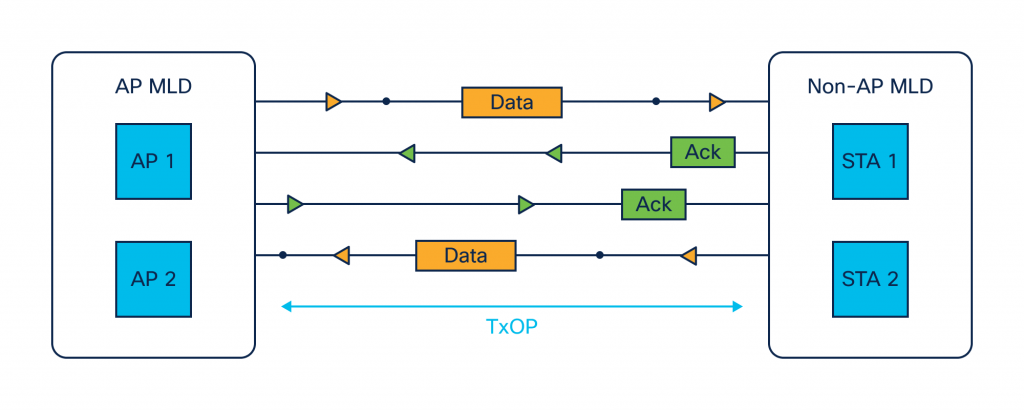
In STR operation, each link can be used to Tx or Rx concurrent physical layer protocol data units (PPDUs) without any synchronization. Figure 2 illustrates an example where an AP MLD and a non-AP MLD are operating over an STR link pair. Both devices contend for access to the wireless medium and engage in subsequent frame exchanges on those links.
After the AP MLD and the non-AP MLD complete a multi-link setup to successfully establish link 1 and link 2, and with the links enabled, AP 2 can receive data frames from STA 2 on link 2. Meanwhile, AP 1 contends for the wireless medium and, upon securing a transmit opportunity (TXOP), transmits data frames to STA 1 on link 1.
Next, let’s conduct a lab test using Cisco’s CW9178 AP running on Catalyst 9800 Wireless LAN controller (WLC) to demonstrate STR in action.
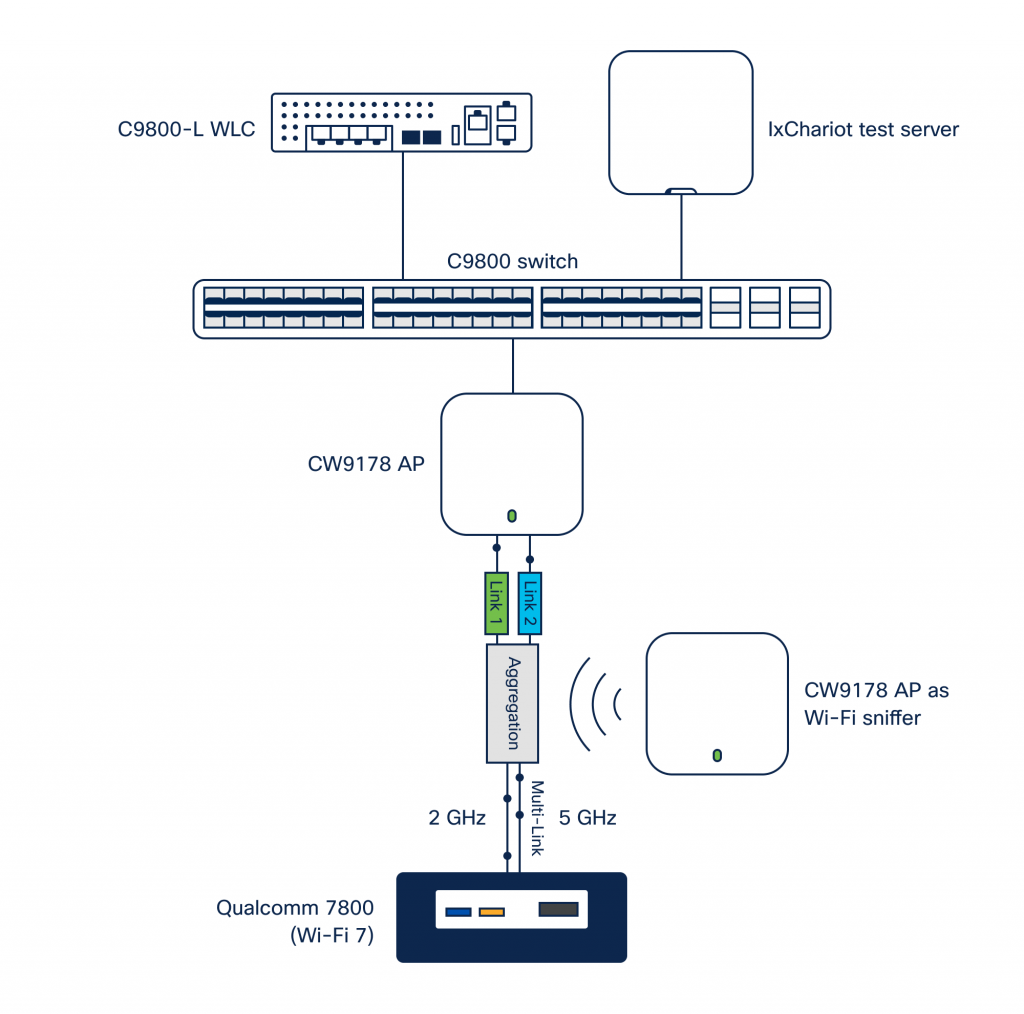
The access point under test (APUT) is configured to operate on 2.4 GHz (20 MHz) and 5 GHz (40 MHz) bandwidths with a WPA3-SAE WLAN. In the first step of the test, Wi-Fi 7/802.11be/MLO is enabled on both bands. We are using a Qualcomm 7800-based STR/MLMR-capable station, while the CW9178 AP serves as the sniffer—capable of capturing data across multiple bands and decoding Wi-Fi 7 frames.
Next, let’s associate the STAUT and check the capability details in both the WLC and Wireshark. During the association process, multiple elements are exchanged: the MLO information elements for the 5 GHz Association link, as well as the “Per-STA Profiles” information elements containing details about the non-association link (2 GHz).
The WLC identifies the STA as STR capable if the “Maximum Number of Simultaneous Links” value in the ML information element of the association request is non-zero. This indicates the number of radios the station is using for its association. See Figure 4 below for the corresponding Wireshark capture.
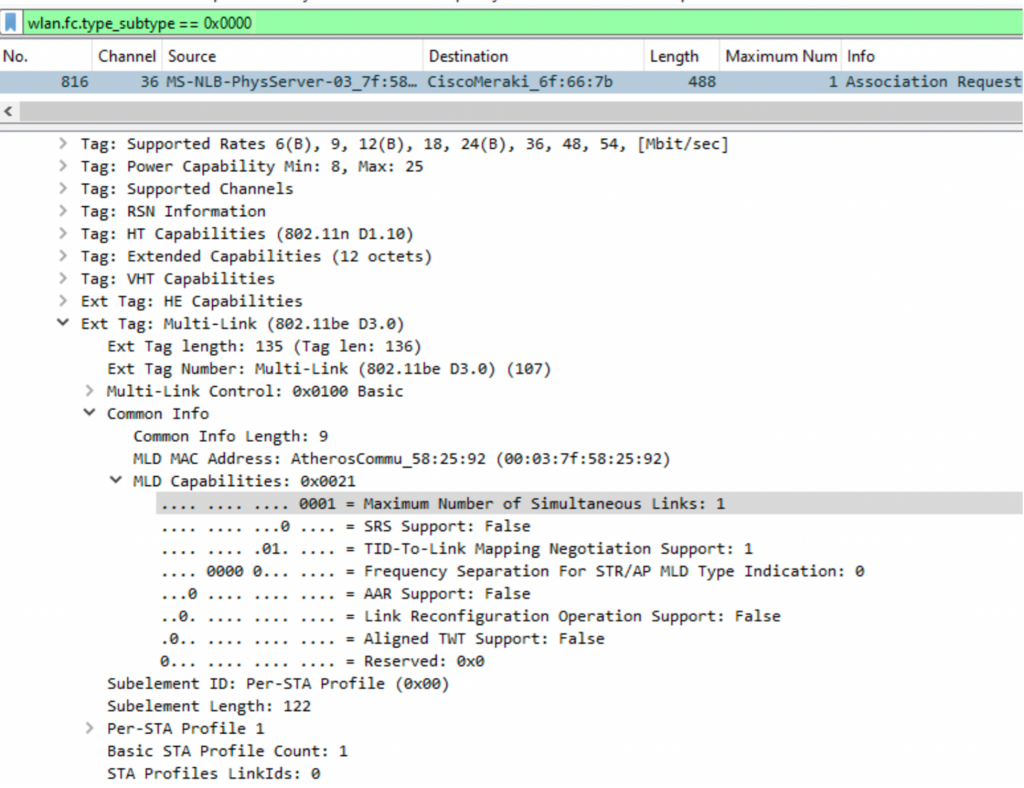
The Catalyst 9800 WLC provides a clear display of the STA’s 802.11be capabilities, including MLD links with Slot IDs and bands, MLO mode support (STR/eMLSR), and Tx/Rx RF and data statistics for each band. Equivalent CLI commands are also available, though not covered in this blog.

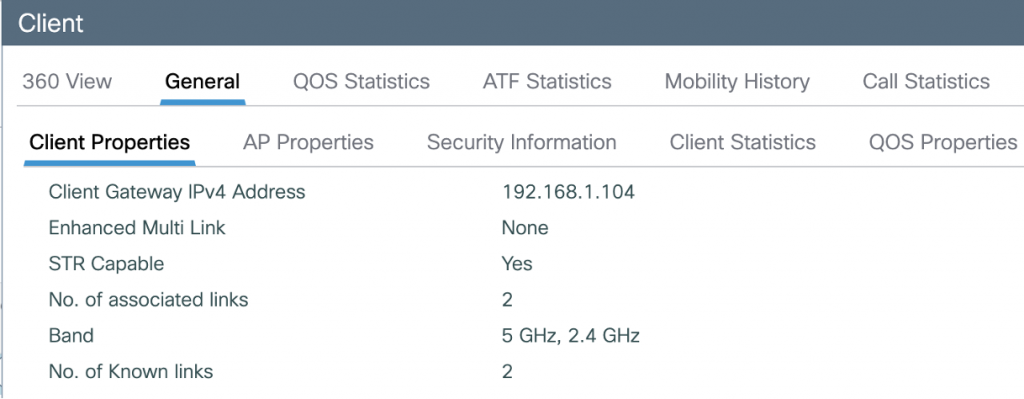
Now that the STA has associated on the 5G band with an STR link to both the 5G and 2G bands, let’s initiate traffic for one minute to verify STR operation. Using the IxChariot server, we will begin full-bandwidth Downlink UDP traffic. Initially, traffic will flow only on the 5G band, as it is the only active association link. However, the STA will soon assess the need for a secondary link to achieve higher bandwidth. It will then send a QoS Null data frame over the secondary (2G) link. The AP acknowledges this request and enables simultaneous data transmission across both bands.
Figure 6 shows the sequence starting with data on channel 36, followed by a QoS Null data frame on channel 6, and concluding with simultaneous data transmission on both channel 6 and channel 36.
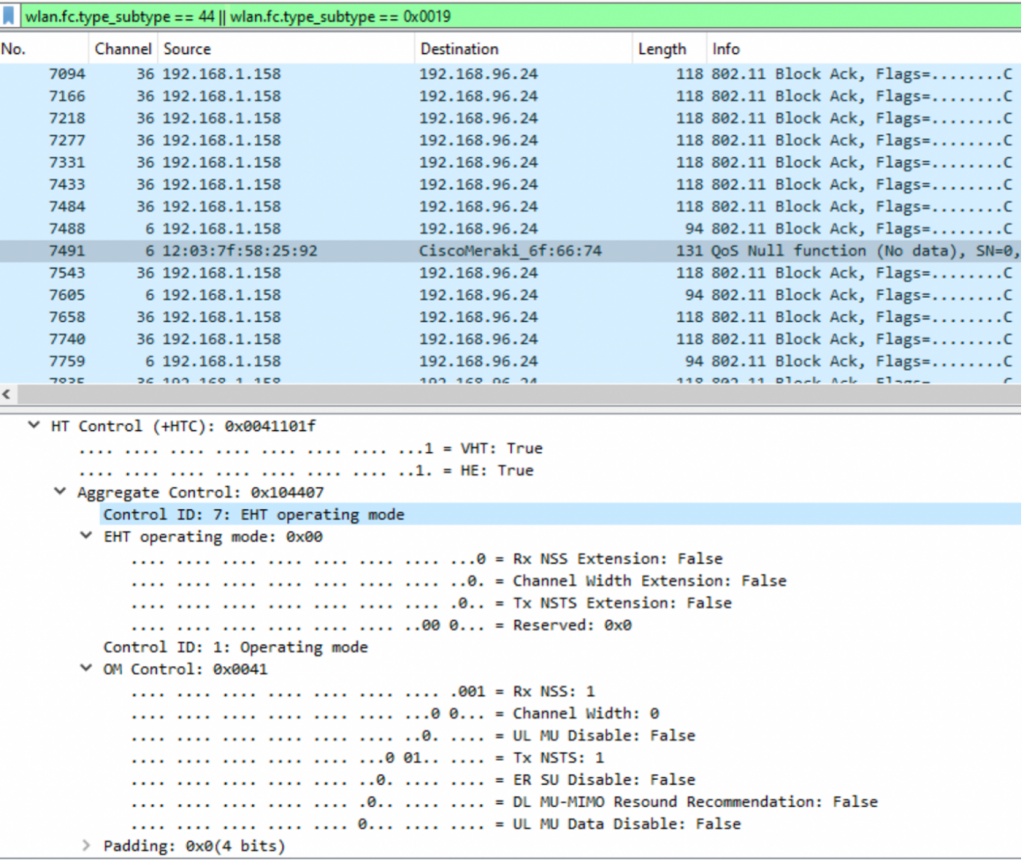
The Catalyst 9800 WLC offers a comprehensive view of the client’s performance on each MLO link, with monitors providing detailed Tx/Rx data along with RF statistics.
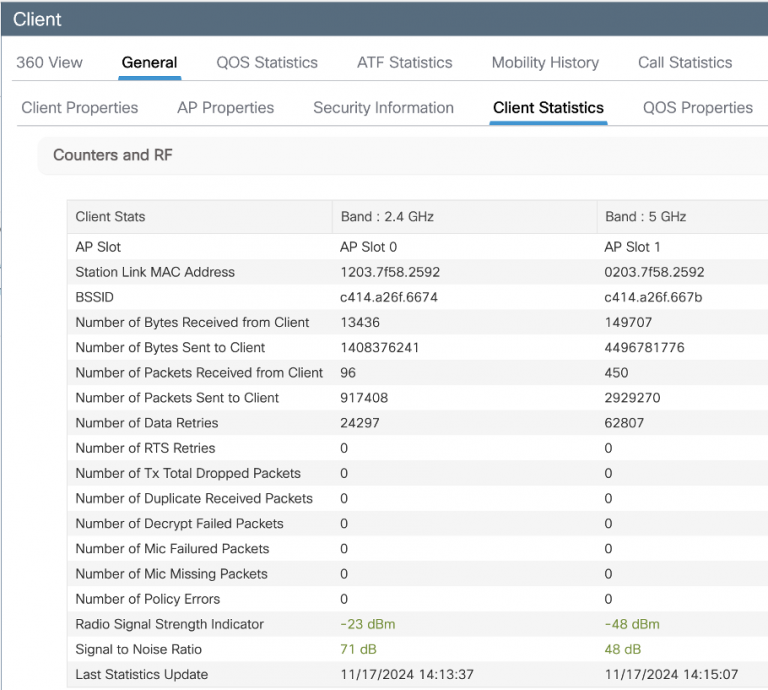
Following the one-minute traffic run, the average throughput measured is 747 Mbps, as shown in Figure 8.

To provide a comparison, the test was repeated under the same conditions, but with 802.11be/MLO disabled, running in 802.11ax mode instead. The average throughput was 506 Mbps.

The table below summarizes the throughput comparison between clients. The impact is indeed transformative: Wi-Fi 7 with STR MLO significantly outperforms Wi-Fi 6, delivering a 47% throughput increase, along with more efficient spectrum utilization.The CW9178, CW9176I, and CW9176D APs, along with 9800 series wireless controllers, will fully support Wi-Fi 7 capabilities and features in the upcoming IOS XE 17.15.2 (currently in Beta) release.

The CW9178, CW9176I, and CW9176D APs, along with 9800 series wireless controllers, will fully support Wi-Fi 7 capabilities and features in the upcoming IOS XE 17.15.2 (currently in Beta) release.
Share:

